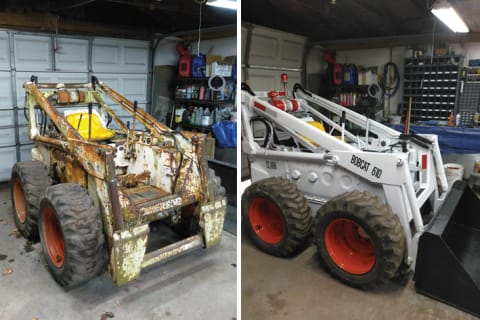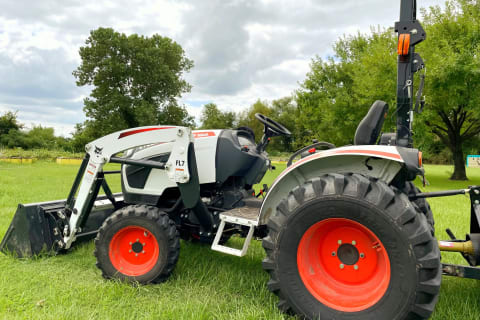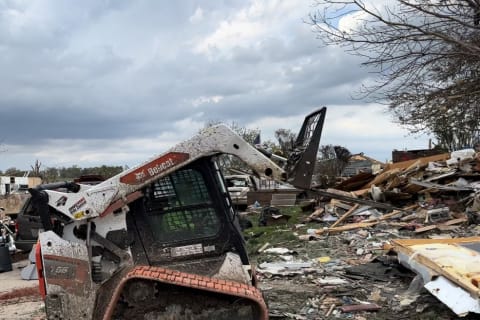- Home
- Company
- News & Media
- Bobcat Stories
- Skid-Steer Loader Restorations of M371, M444 and M610
Bringing Bobcat Loaders back to life: Restoration Series
Published on January 13, 2021
When inventors Louis and Cyril Keller debuted the Bobcat skid-steer loader in 1960, they likely never envisioned this: a vast community of contractors, farmers, landscapers, homeowners and general tinkerers celebrating their machines 60 years later and keeping their legacy alive. These aren’t just jaw-dropping collector’s items – they’re tough as ever. And they do real work, too.
Here are three Bobcat fans celebrating the company’s uniquely storied past and preserving it for the future.
Vintage Bobcat machine

Austin Harrison, from Osmond, Nebraska, stands pridefully next to his 1977 Bobcat M371 skid-steer loader.
The young man with the old machine
Austin Harrison, 25, Osmond, Nebraska
Austin Harrison is a young man fond of old things. The 25-year-old’s vintage Bobcat M371 skid-steer loader was built in 1977. It came off the line nearly 20 years before he did, and that’s what Austin loves about it.
“We just can’t let go of the past,” says Austin, a bit of a history buff. “That got us to where we are. And it’s cool to preserve and hold onto those things.”
No compact equipment company has a legacy like Bobcat, which debuted the world’s first true skid-steer loader in 1960.
“In modern times, there are a lot of different manufacturers of skid-steer loaders,” Austin says. “Bobcat, to me, has always stood out as the leading brand.”
So when a neighbor’s rusted M371 loader went up for sale in early 2020, Austin saw a mid-pandemic project that combined his affection for Bobcat with a real business need. As a truck driver with a weekend mowing business, Austin needed a loader for small side jobs here and there. He also wanted it to deal with the formidable snowbank that rises each winter at his home.
One problem: He’d never restored a loader.
“Thankfully, I’m from a small part of northeast Nebraska where there’s a lot of handy, skilled people who could help me along the way,” Austin says. “And that’s how it took place.”
He scavenged for parts online and leaned especially on a longtime mechanic who lived in town and had worked on Bobcat machines. He replaced the hydraulic pump (which took two months), then the pulleys, then the clutch. The local mechanic replaced eight tiny needle bearings in the machine, tightened the levers and helped add new oil.
Austin placed new Bobcat decals on the previously freshened paint job and took a step back. Four months and $3,900 later, he had a pristine vintage workhorse – a piece of Bobcat legacy that spans generations.
“After doing it, I kind of fell in love,” Austin says. “I’m definitely going to get another Bobcat loader someday, whether it’s a new one or another used one.”
And as for the M371’s future?
“I will hang onto it until the day I die,” Austin says. “And whoever’s alive in my family will get it next.”
Finishing backyard projects in style

Glenn Colassi from Norton Massachusetts uses his Bobcat 1964 M444 Loader for projects around his yard.
Restoring a piece of American ingenuity
Glenn Colassi, 49, Norton, Massachusetts
A nurse anesthesiologist in Norton, Massachusetts, Glenn Colassi wanted a smaller machine in 2013 for several projects around his yard. As a particularly handy guy, he decided to fix up an older loader himself.
That’s how he came upon his first vintage Bobcat machine – a 1964 M444 loader – and, just as importantly, its old Melroe Bobcat manual, its pages still stained with hydraulic fluid.
Flipping through the worn pages, Glenn came away with a deep appreciation of Bobcat and its place in America’s history of industry and innovation. He started a Facebook group, Melroe Bobcat Owners of America, which now has 1,900 members.
“We’re all tied by a love for American inspiration and ingenuity,” Glenn says. “And, if you go back to the Keller brothers and their legacy, you’ll see that in Bobcat Company and its beginnings.”
After restoring the M444, Glenn’s passion for Bobcat machines led him to a worn-out 1971 M371 skid-steer loader. It was overgrown with weeds after two decades exposed to the elements in Middleborough, Massachusetts. Glenn caught wind of the rust-covered machine, owned by a florist in town. He picked it up for $700, beginning a nuts-to-bolts restoration in 2014.
Glenn sandblasted the rust and remaining paint off the machine’s frame and added new tires before priming, painting and applying fresh decals. The hydraulic cylinders, frozen from years of inactivity, required repair at a machine shop. The whole restoration, a 40-some-hour project, totaled $2,375.
Once finished, Glenn proudly parked the restored skid-steer loader on his front lawn, drawing the admiration of passersby. And although he recently sold it to raise funds for his next project, Glenn says it’s in the good hands of a fellow Bobcat fan in western Massachusetts.
“It’s 50 years old, and it’s probably got another 100 years left in it,” he says. “Bobcat, you know, it’s like they say: ‘One tough animal.’”
Restoration at its finest

Michael Knight of Earlington, Kentucky fixes and restores old Bobcat machines to be good as new.
From ‘piddling’ to full restoration
Michael Knight, 49, Earlington, Kentucky
Michael Knight’s used to fixing up Bobcat machines – just never his own.
The 49-year-old mechanic in Kentucky has been repairing Bobcat equipment at mining operations in the state since “forever,” he says. When an out-of-commission M610 skid-steer loader went up for sale nearby, Michael thought it might provide a nice after-hours diversion in his garage. “It was something I could piddle with,” he says.
But then he caught the Bobcat bug.
When the COVID-19 pandemic hit, Michael, like all of us, found himself with more time on his hands. Then the piddling snowballed into a wholesale restoration.
“That’s when this thing kind of grew on me, you know?” Michael says. “If it wasn’t for that, I probably wouldn’t have spent as much time with it. I saw something in it nobody else saw – anybody else would have just junked that one.”
Michael discovered the 1972 loader in “the middle of nowhere” western Kentucky, where the seller said it once faithfully served an old farmer before sitting behind a barn for 10 years.
“It looked like it was ready to go to the junkyard, absolutely,” Michael says. He bought it for $500 anyway.
Upon returning home, Michael found the machine’s motor “locked up tighter than a drum.” Shrugging, the mechanic put a bit of oil down in the spark plug hose and let it set overnight. The next day, he pulled on the drive shaft slightly with a pipe wrench. It moved, no longer stuck.
“When that thing moved, I looked at my wife and said, ‘I can make it run,’” Michael says.
From there it was a matter of taking the machine apart, cleaning it and reassembling it. Even for a seasoned mechanic, installing the bearings and seals proved tricky, “because every time you had to take your sprockets off, your chains off – you had to disassemble the drive system just a little bit to do that.”
But sure enough Michael made it run. The new filters, bearings and seals all came to about $1,300, he says, and the revamped loader became a gift to his father.
But now that he’s caught the Bobcat bug, Michael’s already on the lookout for his next equipment to restore. And after delving into the company’s rich history, he knows it’ll be an orange-and-white machine.
“Reading the story of how Bobcat came about, that’s just what I wanted,” he says. “If I was to find another skid-steer loader, it would still have to be Bobcat.”
Meet an Iowa landscaper who “buys up” Bobcat loaders to refurbish.
More Recent Stories
View All Stories- Bobcat Company Supports The Salvation Army with Equipment Donation
Bobcat Company Supports The Salvation Army with Equipment Donation
Bobcat Company and The Salvation Army unite in partnership with Bobcat donating equipment to strengthen disaster response efforts in communities across North America. - Excavation Company Helps Develop Texas, One Site at a Time
Excavation Company Helps Develop Texas, One Site at a Time
Envirotec Construction Services (ECS) has grown from a small startup to a major excavation contractor in North Texas, utilizing a fleet of Bobcat loaders, excavators, and attachments. - Bobcat Superfan Hits a ‘Homerun’ With Bobcat Equipment
Bobcat Superfan Hits a ‘Homerun’ With Bobcat Equipment
From Syria to Kentucky, Mohamed Edelbi’s built a thriving landscaping and excavation business with Bobcat equipment, crediting dealer support for his success. - Turning Acreage into a Homestead with Bobcat T66 Loader
Turning Acreage into a Homestead with Bobcat T66 Loader
Discover how partners John Lange and Janessa Denman transformed their 44-acre homestead into a forever home with their Bobcat T66 compact track loader and attachments. - Ringers Landscaping Doubles Revenue with Bobcat Equipment
Ringers Landscaping Doubles Revenue with Bobcat Equipment
Ringers Landscaping doubled revenue in three years by optimizing operations and achieving an increase of 40% efficiency with Bobcat equipment and attachments. - Childhood Friends Become Landscaping Pros with Bobcat Equipment
Childhood Friends Become Landscaping Pros with Bobcat Equipment
Childhood friends Anthony Heathco and Colton Roush founded Roadkill Lawncare & Landscaping in Grand Junction, Colorado, starting with a Bobcat® MT100. - Rocky Mountain Stonecrete Completes Challenging Jobs with Bobcat Equipment
Rocky Mountain Stonecrete Completes Challenging Jobs with Bobcat Equipment
Founded in 2006 by Eric Niemann, Rocky Mountain Stonecrete has grown with Bobcat equipment and his loyal crew, by taking on challenging jobs that scare other contractors. - Houston-Based Sweetwater Farms HTX Combines Agriculture with Education
Houston-Based Sweetwater Farms HTX Combines Agriculture with Education
With the help of volunteers, friends, and a brand-new Bobcat® compact tractor, Chaz Daughtry is taking the Houston agriculture scene by storm. - Bobcat Mowers Expands CLK Lawn Care and Landscaping Business
Bobcat Mowers Expands CLK Lawn Care and Landscaping Business
Cody Kuebler started CLK Lawn Care and Landscaping at the age of 11, he expanded his business with two Bobcat ZS4000 Mowers and now his team only uses Bobcat mowers. - Omaha Contractors Provide Tornado Relief with Bobcat Equipment
Omaha Contractors Provide Tornado Relief with Bobcat Equipment
Local contractors in Omaha, Nebraska, including Ideal Construction and Mitera Landscaping, rallied with Bobcat machines to aid in tornado cleanup and community support.
What’s Your Bobcat Story?
Taking on big, ambitious challenges is what being One Tough Animal® is all about. Tell us how Bobcat empowers or inspires you to accomplish more. Whether it’s at work, at play or in life, share your story with us.
Share Your Story








